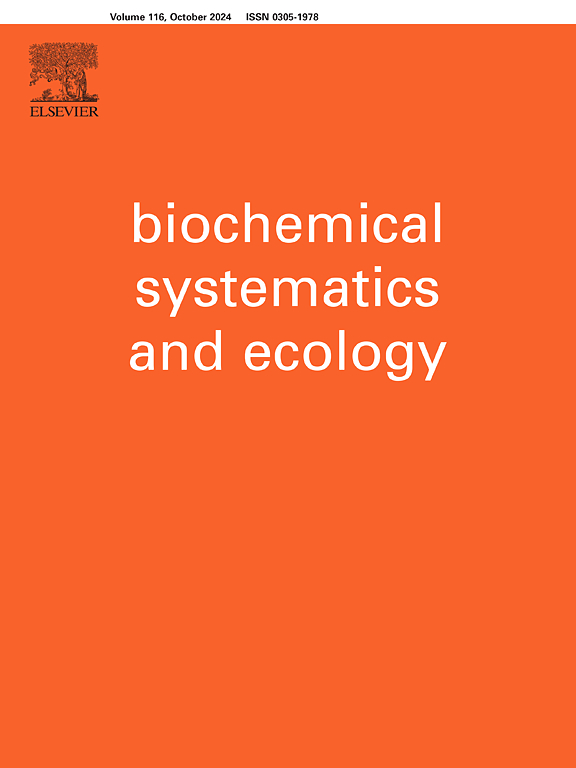利用 LC-MS 和多元统计分析比较 Spondias mombin 和 S. tuberosa 的植物化学成分及其多样性
IF 2
4区 生物学
Q4 BIOCHEMISTRY & MOLECULAR BIOLOGY
引用次数: 0
摘要
Spondias mombin 和 Spondias tuberosa 是天南星科的果实植物,这些植物的果实分别被俗称为 "cajá "和 "umbu",在巴西被作为外来水果销售。这些物种的遗传变异以及对繁殖、收获和保存技术的缺乏阻碍了它们在市场上的推广销售。因此,巴西农业研究公司(EMBRAPA)建立了积极的种质库(AGBs),以保护遗传资源并优化这些物种的利用。代谢组学研究是选择物种的方法之一。在这项工作中,利用基于液相色谱-质谱联用技术的代谢组学,采用多元统计分析方法对 S. mombin 和 S. tuberosa 树皮、树枝和树叶的代谢组学特征进行了相关分析。因此,确定了对观察到的群体影响最大的化合物,并将其作为这些物种的化学标记。为了对代谢组图谱进行去复制,构建了一个天南星科植物化学结构库,从而鉴定出了 40 种化合物,其中 10 种化合物通过使用化学结构库和参考标准达到了 1 级水平,30 种化合物仅通过使用化学结构库达到了 2 级水平。本研究的结果表明,树枝和树皮中含有没食子酸和柠檬酸作为化学标记,它们在不同物种之间的特征相似。在桑白皮的叶片中,C17:3 邻苯二甲酸和槲皮素衍生物被确定为化学标记,而在块茎桑的叶片中,C17:1、C17:2 和 C13 邻苯二甲酸被确定为化学标记。与遗传变异相比,气象因素对叶片代谢特征的影响更大。就 S. mombin 叶片而言,黄酮类化合物与云量成反比,与采集地点的温度成正比。本文章由计算机程序翻译,如有差异,请以英文原文为准。
Comparison and diversity of phytochemical profiles of Spondias mombin and S. tuberosa using LC-MS and multivariate statistical analysis
The species Spondias mombin and Spondias tuberosa are fruit plants from the family Anacardiaceae, and the fruits of these plants are popularly known as “cajá” and “umbu”, respectively, and are marketed as exotic fruits in Brazil. The promoted marketing of these species in the market is hampered by their genetic variability and a lack of knowledge of techniques for reproduction, harvesting, and conservation. Therefore, active germplasm banks (AGBs) were created by The Brazilian Agricultural Research Corporation (EMBRAPA) to conserve genetic resources and optimize the use of these species. One of the approaches to the selection of species is metabolomics studies. In this work, using liquid chromatography‒mass spectrometry-based metabolomics, multivariate statistical analysis was used to correlate the metabolomic profiles of the bark, branches, and leaves of S. mombin and S. tuberosa. Thus, the compounds that most influenced the observed groups were identified and indicated as chemical markers of these species. To carry out the dereplication of the metabolomic profiles, a library of chemical structures of the Anacardiaceae family was constructed, which enabled the identification of 40 compounds, 10 of which were at level 1 using the library and reference standards and 30 at level 2 using only the library. The results of the present study showed that the branches and bark contain gallic acid and citric acid as chemical markers, and their profiles are similar between species. In the case of the leaves of S. mombin, the anacardic acid C17:3 and quercetin derivatives were identified as chemical markers, while the leaves of S. tuberosa contained the anacardic acids C17:1, C17:2, and C13 as chemical markers. Meteorological factors had a greater influence on the metabolic profile of the leaves than did genetic variability. In the case of S. mombin leaves, flavonoids are inversely correlated with cloudiness and directly correlated with the temperature at the collection site.
求助全文
通过发布文献求助,成功后即可免费获取论文全文。
去求助
来源期刊

Biochemical Systematics and Ecology
生物-进化生物学
CiteScore
3.00
自引率
12.50%
发文量
147
审稿时长
43 days
期刊介绍:
Biochemical Systematics and Ecology is devoted to the publication of original papers and reviews, both submitted and invited, in two subject areas: I) the application of biochemistry to problems relating to systematic biology of organisms (biochemical systematics); II) the role of biochemistry in interactions between organisms or between an organism and its environment (biochemical ecology).
In the Biochemical Systematics subject area, comparative studies of the distribution of (secondary) metabolites within a wider taxon (e.g. genus or family) are welcome. Comparative studies, encompassing multiple accessions of each of the taxa within their distribution are particularly encouraged. Welcome are also studies combining classical chemosystematic studies (such as comparative HPLC-MS or GC-MS investigations) with (macro-) molecular phylogenetic studies. Studies that involve the comparative use of compounds to help differentiate among species such as adulterants or substitutes that illustrate the applied use of chemosystematics are welcome. In contrast, studies solely employing macromolecular phylogenetic techniques (gene sequences, RAPD studies etc.) will be considered out of scope. Discouraged are manuscripts that report known or new compounds from a single source taxon without addressing a systematic hypothesis. Also considered out of scope are studies using outdated and hard to reproduce macromolecular techniques such as RAPDs in combination with standard chemosystematic techniques such as GC-FID and GC-MS.
 求助内容:
求助内容: 应助结果提醒方式:
应助结果提醒方式:


